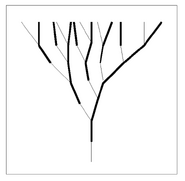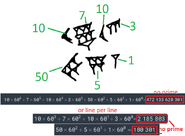This is mostly a talk page. Any additional information will be welcome.
Low occurrence of two-same-rune bigrams[]
After a lot of analyzing of runes in unsolved pages of LP only conclusion we figured out is that LP is not coded by simple short key Vigenere cipher (or mono-alphabetic cipher).
Analysis of two grams (pairs of runes) is the only deviation from randomness of other analysis results. It shows strange and unexpected low number of rune pairs with two same runes. Somehow key/cipher produces very few same rune pairs in ciphertext. Same runes 2-grams happen but are very rare.
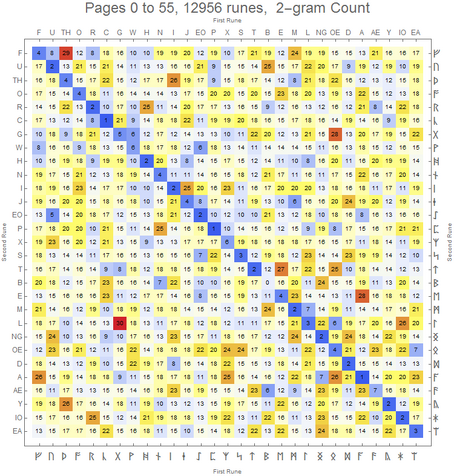
Its almost impossible that such low occurrence (86 same rune 2-grams in ~13.000 runes) would happen randomly using standard polyalphabetic cipher with most stream shift keys. Algorithm or stream key for some unknown reason cause this. This is so far only solid clue towards cipher/key found in runes.
We have found some sequences of numbers that when used as a stream key produce low number of same rune 2-grams. This is example: https://oeis.org/A061474, or this http://pastebin.com/PFb6eQiD
And we can reproduce similar results with made up enciphering algorithms created to deliberately cause same thing. Such algorithms include previous rune gematria position or value when calculating shift for enciphering. Note that cipher doesnt totally exclude 2 rune repetition, it only makes it happen ~5 times less likely as any other 2 different rune 2-gram.
For more info see:
https://docs.google.com/spreadsheets/d/1-Tqf9SuLXv75YQfpAr7zIm7s1oF4ZWO_jqU-sg9PuN0/edit#gid=0
Bruteforce Software & Programs Section[]
Cicada_Breaker[]
This is a tool I programmed to find words with a repeated letter in a specific position, or even a sequence with different letters. Note: You need Linux to run it.
Launch a terminal from the same folder containing the program, write ./Prog then press enter if you want to use the 1-sequence mode, or ./Prog2 for the 2-sequence mode.
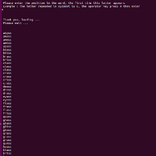
Update 1.0: This tool will allow you to find for example words like: xxxSS, xxBBxxxx, xxxOUxxxx, xABxxxxx ... You have to enter the length of the word, the sequence you're looking for, and its position in the word. The tool will give you all the words with this combination. For this beta version you can use only 360 000 words, I will work on it in order to use the whole dictionary. Notice that it is very optimised, it will take no time. Update 1.1: - Some bugs now are corrected - Optimization ++ - 3 new modes 1 : Fixed length / Fixed position 2 : Free length / Fixed position 3 : Fixed length / Free position 4 : Free length / Free position Update 1.2 : - 2 new modess: 5 : One character / Fixed position / Fixed length 6 : One character / Fixed position / Free length Update 1.3 : - 8 new modes for 2 sequences - You have many combines for the searched sequences based on the length of the word containing the sequences (fixed and free), the order of sequences (fixed = one before the other, free = all possibilities for them) and their position (Fixed seq_1 at position X and seq_2 at position Y). PSY: A Bruteforce code may come in the next updates PPSa: Next step the Bruteforce program
Cicada_solver
EDIT : Instructions on how to help us with runes guessing and what we are looking for based on my conversation with Cicada_Solver and XDDD dude
For example : ᚳ ᛁ ᚱ ᚳ ᚢ ᛗ ᚠ ᛖ ᚱ ᛖ ᚾ ᚳ ᛖ - C I R C U M F E R E N C E - this 13 letter word was not encrypted at all ( all it took is to look at the gematria and replace runes with letters) . There are only 4 words that long in the entire book :
ᛇᛈᛋᚢᛚᚪᛈᚢᚳᛖᚠᛞᛉ - (EO ) P (S/Z) U L A P U (C/K) E F D X
ᛖᛞᚪᚫᛏᚩᛠᛖᛠᛉᚳᛠᛏ - E D A (AE) T O (EA)E (EA) X (C/K) (EA) T
ᛈᚳᛇᚢᛏᚳᛡᛇᛝᚾᚢᚻᚦ - P (C/K) (EO) U T (C/K) (IA/IO) (EO) (NG/ING) N U H (TH)
ᛒᛠᚠᛉᛁᛗᚢᚳᛈᚻᛝᛚᛇ - B (EA) F X I M U (C/K) P H (NG/ING) L (EO)
or
ᚳ ᛁ ᚱ ᚳ ᚢ ᛗ ᚠ ᛖ ᚱ ᛖ ᚾ ᚳ ᛖ ᛋ - C I R C U M F E R E N C E S - this 14 letter word was also not encrypted . There are 3 more words that long in the book :
ᛒᚷᛞᛉᛗᛒᛉᚳᛝᚦᚣᛞᚫᛠ - B G D X M B X (C/K) (NG/ING) (TH) Y D (AE) (EA)
ᛠᛁᛡᚦᛝᚾᛖᚾᚠᚩᛗᛖᚣᚪ - (EA) I (IA/IO) (TH) (NG/ING) N E N F O M E Y A
ᛏᚠᛂᚱᚹᚠᛋᚾᚹᛂᛖᛒᚢᚦ - T F J R W F S N W J E B U (TH)
The explanation from Cicada_Solver : Let's take the word "CIRCUMFERENCES". If we assume the word repeats itself in the book and you think that after encryption it gives ᛏᚠᛂᚱᚹᚠᛋᚾᚹᛂᛖᛒᚢᚦ - T F J R W F S N W J E B U (TH) then you have to guess which operations have been applied on the word ᚳ ᛁ ᚱ ᚳ ᚢ ᛗ ᚠ ᛖ ᚱ ᛖ ᚾ ᚳ ᛖ ᛋ ( CIRCUMFERENCES) with the gematria to have the result ᛏᚠᛂᚱᚹᚠᛋᚾᚹᛂᛖᛒᚢᚦ ( T F J R W F S N W J E B U (TH) )
When you have an idea try it on other words and correct your guess since you can verify the other possibilities (if you detect a rune, then use cicada_breaker to guess the others one by one and remember each rune reduce the possibilities from n! to (n-1)!).
If everyone try this, by the end we would have lots of runes guessed (wrong and maybe right) but it is the same operation so we all think about the results and a dozen of minds are much better than one for this task. By comparing the results we can be sure about some runes.
Don't forget that an operation should be bijective and should be able to be reversed otherwise the operation of encryption/decryption could not be executed, so Cicada has necessarily used bijections to encrypt Liber Primus.
And when we have some runes guessed we can launch the bruteforce program.
Anybody that wishes to help - please download the software and try this method . The more people on it the more info for bruteforcing.
I have 29! possibilities which is about 8.841762*10^30 permutations, if we suppose that there is no other operations added on the other pages, this is just not possible to calculate even with super calculators I've got in labs (in which case it would take years before having the solution). It is a factorial-complexity so it is O(n!) for 2X variables we need 1000 years to find. (For n = 20 it takes about 800 years)
In mechanical engineering, we deal with problems like this one since the inversion of a matrix needs the calculation of determinants and the law looks like this one O(n!), we transform the system to another form having a polynomial-complexity O(n^p) then we have our solution in no time.
The Liber Primus problem is easier cuz we have words and sequences (this is its Achilles' hell), which can be guessed cuz they are comprehensible not like numbers and results of a calculation for determinant (In CFD and FEM the dimensions of the problem give us n = 10^9 easily ... so it is 10^9! operations).
I maybe repeate what I've said, but it is important to guess runes with the cicada_breaker V1 I gave you, it would reduce the possibilities to 2.092279*10^13 possibilities and this is rational to bruteforce in labs.
When I said statistical studies and probabilities, you have to take the decrypted pages, take the words reapeated and look for them in the other pages since lenght is known. What you should do is to take long words, write them in runes and copare them with long words from Liber Primus, if you figure out about the permutations applicated on the word, each time you reduce the possibilities from n! to (n-1)! and so on, and this is why I said that is ok if the runes are wrong, the calculation doesn't take time and the worst thing that could happen is having a wrong text. By the end we eliminate the "lenght-of-the-word" possibilities, and since the word is a finite space we can try all the other possibilities by hand.
The only solution to bruteforce is to cut the gematria table to 1X - 1Y permutations, 1X to guess and 1Y to bruteforce.
Dr B 67
Python Program for Solving Runes:[]
A collaborative effort to get as many different cyphers put into the program: https://github.com/Be5haram/CICADA2K16/blob/master/RuneSolver.py
Pages 8-14 straws/saplings meanings & Discoveries[]
Fibonacci Tree reference[]
The saplings from page 8 and on represent the Fibonacci tree. The top of the sapling has exactly 13 branches, which is the number you'd expect from a Fibonacci tree like the one on the right. To find more: http://oeis.org/A000045/a000045.html
So the highlighted branches are: 2-3-5-6-8-10-11-13. Anything up with this? Branch 2 and branch 5 make me think of runes somehow.
There are 58 pages in total, labeled 0-57. 57 is the most accurate integer that can be squared to reach a number closest to 3301.
This leads me to believe that the page number is extremely relevant to solving the next stage of this puzzle. Seeing as page 57 is unencrypted, I believe that we are looking for an encryption where the page number (x) can be substituted with 57 (or 58) to equal 0, since the 57th (or possibly 58th if you count the number of pictures) runic page is unencrypted.
From this I think it is aiming at page 32 and maybe 26 or something like that. And by the way in this titanpad https://titanpad.com/vFCy7T5p0O with the runes and its transcriptions in a few pages there are
--
- 58 pages named 0-57.
- 3301/57 = 57.9122807018 which makes it the closest to its root
- 1033/32 = which also makes it the closest root
- 57.9122807018 : 32.28125 = 1.7939912705301
Artifex[]
Last pages opened up in editor says "Copyright Artifex Software 2011"
http://www.artifex.com/ http://www.ghostscript.com/ http://smartoffice.artifex.com/ http://www.mupdf.com/
Cuneiform[]
(17 13 55 1)
17*60+13=1033
55*60+1=3301
http://it.stlawu.edu/~dmelvill/mesomath/Bignums.html
Another instance of 15[]

Probably a coincidence, but of note.
Research on apostrophe symbol on page 35[]
Since apostrophes' usage are limited in English, I found this:
PE'T in the beginning of a sentence on 4th line.
I guess this is IT'S. And then calculated the shifting, I got this numbers (3,2,1).
Liber Primus in gematria values[]
Here is link to unsolved pages of Liber Primus in gematria values. http://pastebin.com/NrLjVjdq
Pages: https://imgur.com/a/8xnWx#0
UPDATE: Algorithm that generates low same-two bigrams[]
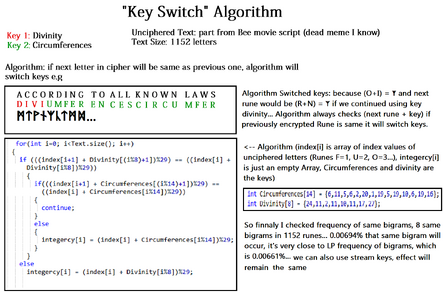
Algorithm generates extremely low same-two bigrams in cipher...
also you can archive same effect if you jump to (n+1)th number in stream key, or if you reset the key, instead of switching it... there are many possibilities
Frequency analysis of runes in Liber Primus by chapters[]
Nothing unexpected, distribution of runes is close to random distribution. Google doc sheet
Hcaltroms version: http://imgur.com/D7wpFZG
3 ways how to apply key to runes in cipher text[]
Often when encrypting / decrypting, you want to combine a message-rune with an encryption key to give a cipher-rune. The encryption key can be expressed as another rune. Therefore, it is informative to investigate possible ways that this can be done. Presented below are some common examples. The runes have two numbers that can represent them, their position (pos) in the Gematria Primus or their rune-prime-equivalent (pri). So there are four possible combinations, (where r is any rune)...
Full article: http://cicada3301.boards.net/thread/31/combining-runes-1-visual-representation
Another one: http://cicada3301.boards.net/thread/33/modular-exponentiation-ciphers-runes
Author: mortlach
Spreadsheet for decoding Liber Primus[]
http://cicada3301.boards.net/thread/43/rune-decrypting-spreadsheet
drive.google.com/open?id=0BzOKQofOkvB3YmR1cjJCZGNCdXM
Guide on how to use the spreadsheet:
- Sheet2 is the Gematria converted to shifts. To create these shifts we use the Prime Counting Function ,Pi(p), on the prime numbers associated with each letter in the Gematria.
- page_x is the xth page of the Liber Primus. There are 58 pages total, beginning with a count of 0 we have pages page_0 to page_57
(*) There are many "hidden" pages in the spreadsheet for organization, right click on the bottom and select "unhide" imgur.com/asLy62L
(**) The visible pages are those that begin each distinct section of the Liber Primus. The current theory is that each section uses a different key, so these pages are the best to start.
- Top row is the original cipher text of the page. imgur.com/wZVmpq9
- Rows 3-32 are the shifts from the cipher text in row 1 imgur.com/UasnRcL
- Rows 35-64 are the english letters corresponding to the shifts in 4. imgur.com/RQANPSJ
- Rows 66 - 70 are the ones to use. imgur.com/RHV0bYJ
The "Count" row denotes the index corresponding to the letter position on the page. The "Modifier" row is the Encryption Key - use this to try various key sequences. The Modifier (Key) is applied to the cipher text to obtain the "Decoded" row.
See page_56 and page_57 to see how these were decrypted. Page 56 uses the "Count" row to look up the index of the prime corresponding to Pi(count) and subtract it from 59, mod 29.
Ether8unny CICKADA tool[]
As seen on TV!
https://ether8unny.shinyapps.io/cickada/
Repeat of "DJU BEI" in Liber Primt[]
We found that string " DJU BEI" or in runes "-ᛞᛄᚢ-ᛒᛖᛁ" repeats two times in Liber Primus. On 27.jpg and 55.jpg.
Both times next character after DJU BEI is "AE" "ᚫ". But on page 27 its mid sentence while on page 55 it appears on next page in new paragraph.
This could mean that same key and same plaintext was used on that string or it could be just coincidence.
Links that can be usable investigating this:
- https://github.com/rtkd/iddqd/tree/master/liber-primus__images--unsolved
- https://github.com/rtkd/iddqd/blob/master/liber-primus__transcription--full/liber-primus__transcription--full
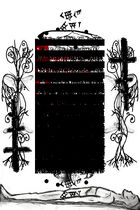
Etherpad with ideas about possible ciphers[]
https://etherpad.wikimedia.org/p/cicada
Untried methods to solve LP Methods: • Using the outguess data to relocate the runes before shifting them. • Counting spaces AS runes instead of not. • Breaking LP into sections and applying the gematria value of the first rune to shift the next rune. Or the pi_digit(n)th rune. Or variations. • Applying gematria value of the first rune to the last rune (of the section). • Re:rune analysis. • Translating runes > old english > english. • Something similar to that [3301-fib prime] spiral from page 15 ( http://uncovering-cicada.wikia.com/wiki/Onion_7:_numbers_on_page_15 ) Ideas: • Maybe it was written backwards or upside down. • Multiple different languages. • LP can be divided into sections by artwork used on pages. • “Find the divinity within and emerge” could be a reference to finding the word “divinity” to help figure out the pattern. • Fibonacci trees - Beaufort cipher? • Spirals - Route cipher? • Undecrypted pages may not use words. Maybe binary. • Rune - base29 integer? • https://en.wikipedia.org/wiki/DADGAD tuning of mp3’s?
An observation about page markings[]
I had a search through the wiki, and noticed that somehow no-one had pointed out that the dots that look like stars on pages 23 and 56 look really similar to the constellation Crux, also known as the Southern Cross. I doubt this helps any, but I thought I'd point that out on the off chance it's of any use. This constellation is on the Australian and New Zealand flags as well, and might hold other significance that I'm not aware of.
| |||||||||||

